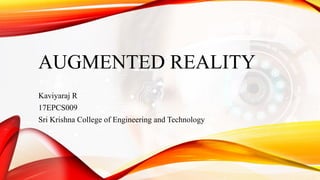
Augmented reality
- 1. AUGMENTED REALITY Kaviyaraj R 17EPCS009 Sri Krishna College of Engineering and Technology
- 2. AGENDA What is augmented reality Introduction Augmented reality vs Virtual reality How it works Applications Advantages Disadvantages Future scope References
- 3. WHAT IS AUGMENTED REALITY…?
- 5. INTRODUCTION Augmented Reality (AR) is a general term for a collection of technologies used to blend computer generated information with the viewer’s natural senses. Augmented reality is the integration of digital information with the user's environment in real time. It works on computer vision based recognition algorithms to augment sound, video, graphics and other sensor based inputs on real world objects using the camera of your device. Hardware components for augmented reality are processor, display, sensors and input devices.
- 6. VIRTUAL REALITY VS AUGMENTED REALITY
- 7. HOW IT WORKS Augmented realities can be displayed on a wide variety of displays, from screens and monitors, to handheld devices or glasses. Key Components to Augmented Reality Devices Sensors and Cameras Processing Projection Reflection
- 8. HOW IT WORKS(CONT.) Sensors and Cameras Sensors are usually on the outside of the augmented reality device, and gather a user's real world interactions and communicate them to be processed and interpreted. Cameras are also located on the outside of the device, and visually scan to collect data about the surrounding area. Depth sensing cameras work in tandem with two "environment understanding cameras" on each side of the device. Processing Augmented reality devices are basically mini-supercomputers packed into tiny wearable devices. These components include a CPU, a GPU, flash memory, RAM, Bluetooth/Wifi microchip, global positioning system (GPS) microchip, and more.
- 9. HOW IT WORKS(CONT.) Projection While “Projection Based Augmented Reality” is a category in-itself, we are specifically referring to a miniature projector often found in a forward and outward-facing position on wearable augmented reality headsets. Reflection Mirrors are used in augmented reality devices to assist with the way your eye views the virtual image. The use of “mirrors” involves see-through holographic lenses (Microsoft refers to them as waveguides) that use an optical projection system to beam holograms into your eyes.
- 10. APPLICATIONS eCommerce Gaming Navigation Photo Filters
- 11. E-COMMERCE
- 12. GAMING
- 13. NAVIGATION
- 14. PHOTO FILTERS
- 15. ADVANTAGES Enrich Content Object Visualization Increase Sales
- 16. DISADVANTAGES Eye Strain Diziness Distortion
- 17. FUTURE SCOPE GPS and other in-car displays are great for getting us from point A to point B, and some high-end vehicles even have displays on the windshield, but in the near future cars will be able to identify external objects in front of the driver and display information about them on the windshield. New and future systems will be able to display more information in the windshield.
- 18. REFERENCE http://www.realitytechnologies.com/augmented-reality https://www.youtube.com/watch?v=4jrhw_ZRjV4 https://www.youtube.com/watch?v=_EfMCTOQd6A https://en.wikipedia.org/wiki/Augmented_reality https://venturebeat.com/2017/08/23/ar-will-drive-the-evolution-of-automated-cars/
- 19. THANK YOU
Notas del editor
- A combination of a real scene viewed by a user and a virtual scene generated by a computer that augments the scene with additional information.
- Augmented reality is changing the way we view the world
- vr- virtual world+real ip(person complete in immersive environmt) ar-real wrld+virtual layer(person maintains sense of presence in real world)
- Recognition Tracking mixing